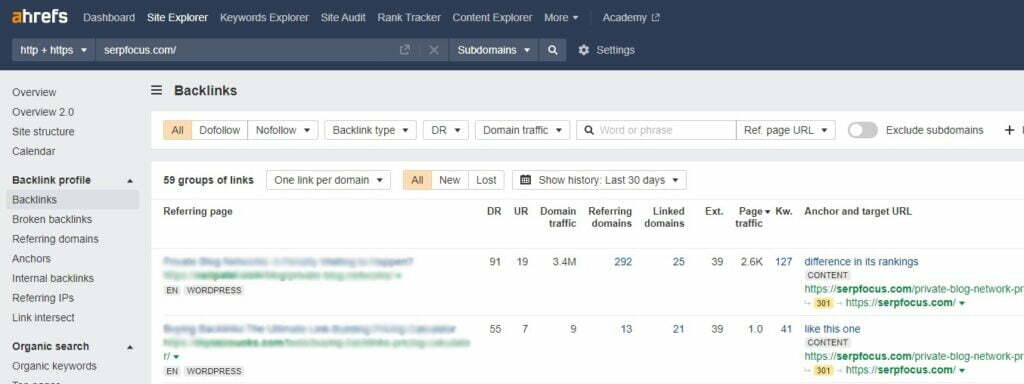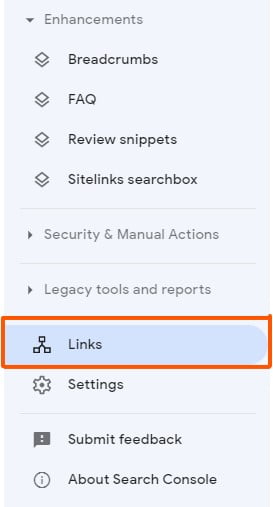You’ve built a fast, clean, and beautiful website. You’ve filled it with relevant keywords and optimized content.
But it’s just not ranking.
What’s missing?
Backlinks. Each time you get a backlink from an authoritative site, it directly affects your rankings in search engines (usually for the better, but not always).
If you aren’t sure why your competitors are outranking you, take a look at your backlink profile versus theirs.
Your backlink profile lists every link your website has received from another website. A backlink profile measures the quality of each link, so you can see if they’re helping or hurting your site.
That last part is important—not all links help your rankings.
Backlinks aren’t the easiest thing to build, but they’re paramount to your rankings.
Today, I’m looking at what backlink profiles mean for your website and how you can improve yours. I’ll show you how to take your backlink profile from barely there to a force to be reckoned with.

What Is a Backlink?
Let’s start with the basics:
A backlink is like a vote from one website to another. It tells Google, “This site I’m pointing at? Their content is so valuable, well-researched, and original that I’ve referenced it on my own site.”
Backlinks have a serious impact on your rankings. One study found that the total number of sites linking to yours was more correlated with higher rankings than any other ranking factor!
See what I did there? That was a backlink. I’ve just given that website a valuable boost to its backlink profile. You’re welcome, Backlinko!
Backlinks provide valuable resources to your reader. Like in the example above, backlinks are a way to include original research in your content and back up your claims.
That’s why you want to write content that’s full of research or original thought—you increase the chances that someone will link to it!
Side note: Don’t confuse backlinks with internal links. An internal link comes from your own website. It points to another page on your site. For example, here’s an internal link to the SerpFocus homepage.
What Is a Backlink Profile?
It gives you a bird’s eye view of all the links going to your website. With your backlink profile, you’ll see:
- The total number of links pointing to your site
- The different websites that have linked to yours
- The quality of those links (How authoritative are those sites? How relevant are they to your niche?)
- The anchor text used for those links
Backlink Profile Health Factors

What separates a good backlink from a bad one? As I mentioned earlier, some links do more harm than good for your site. You can measure the quality of a backlink by looking at the following:
When a high-authority website links to yours, it passes on some of its authority to you.
So, what makes a website authoritative? It has to do with the site’s domain authority or domain rating score (a metric developed by ahrefs, which is an amazing tool. You can read my full ahrefs review here).
Both measure (you guessed it) the authority of a website. Although these metric aren’t ranking factors that Google uses; sites with a high DA/DR tend to correlate with higher rankings.
A few factors that affect a site’s authority include:
- Backlink profile
- The position of that website in search engine results
- Age of the domain
You can check a website’s authority using Moz, Semrush, or Ahrefs.
How relevant is the referring site’s topic?
Let’s say you run a website all about HVAC systems. You have content about installing, maintaining, and repairing furnaces and air conditioners for homeowners.
A backlink from a website about home renovations would be pretty relevant to your niche. So would a link from a site about increasing energy efficiency in homes.
But what about a link from a site focused on cryptocurrency?
Since that website has no relevance to your own, a backlink from it would do little to improve your rankings. It could have the opposite effect since Google may see it as spam.
When you’re acquiring links, focus on getting them from sites that are related to your own.
Healthy backlink anchor text ratio
Anchor text is what a link attaches to. It serves two purposes: It tells users what to expect when they click the link, and it helps Google contextualize that link. Anchor text is underlined and a different color from the other text, like this!
There are three main types of anchor text you can get:
- Keyword anchors. Trying to rank for a target keyword? Use it in your anchor text! If you’re asking other sites to link to yours, you could ask them to use a specific anchor text. For example, your HVAC site might have incoming links with the anchor text: “Residential HVAC services”.
- Branded anchors. This is a link that states the name of your brand. Ex) McDonald's, Nike, or Coca-Cola. If you’re trying to build brand awareness, this is a good way to do it.
- Naked URLs. Rather than customizing the anchor text, you simply keep it as the link URL. It’s a great way to make your backlinks look more organic.

Ideally, your site should have a healthy mix of all three. Too much of one type can skew your backlink profile. If you only have keyword anchors, your site will be over-optimized and could see rankings drop as a result.
Variety of link types
You know you need more backlinks—but which type of backlinks will be best? Diversify your profile with a mix of dofollow links (which pass authority to your site) and nofollow links (which do not pass that authority).
You want to make a natural backlink profile, so try to get a mix of both!
How To See Your Backlink Profile
To see your website’s backlink profile, you can use a data source tool. A popular one is Google Search Console. I like to use Semrush and you'll see why.
What Does a Bad Backlink Profile Look Like?
Here’s what you don’t want in your backlink profile: Links from irrelevant websites, dozens of links all from the same website, or an anchor text ratio that’s too skewed in one direction.
If you want to get a closer look at your site’s backlink profile, you can use the following tool:
Semrush's Link Toxicity Report
Looking for a faster way to weed out bad links? Semrush does it for you. Set up a backlink audit in the software to get the overall toxicity score of your backlink profile. At a glance, you can see which links are hurting your site’s domain authority.
For more information, check out my Semrush review.
Disavowing bad links & domains
What if a competing HVAC company starts getting you backlinks from all the wrong sites? To tank your rankings, they start posting your URL on irrelevant, spammy sites.
Don’t worry: You can get rid of them by disavowing the links. It’s a way of telling search engines to ignore a backlink so that it won’t affect your website.
Google is always updating its algorithm, and one of its goals is to disavow poor-quality links automatically. But if you want to take matters into your own hands, use Google’s Disavow Tool.
How To Gain More Backlinks
You’ve determined that your website needs one thing, and one thing only: More backlinks! It’s the best way to improve your link profile.
So, how do you do it? It’s not as simple as asking other sites to link to yours. Most authoritative sites get messages like this every day!
You need to stand out if you want links. A few strategies you can use are:
- Create well-researched, original content. Write blogs that other sites will link to naturally. To do this well, you need to write content that your competitors haven’t already posted. Conduct original research. Send out a survey and compile the results. Or share your thoughts on a trending topic in your industry.
- Reach out to high authority sites. Found a site you want a link from? Reach out to them! Most likely, they won’t simply hand over a link. You’ll have to earn your keep. Try offering to write a high-quality blog where you can include your link naturally. Learn more about guest posting in our recent blog post.
Tier 2 Backlinks
Backlinks are links obtained from sites with good authority that link back to your site. Tier 2 links are links from sites with lower authority that link back to sites that have already linked to you, forming a chain. Tier 2 links help build a natural linking structure and pass authority indirectly.
Need Help Building Your Backlink Profile?
As you continue link building, keep an eye on your backlink profile. You can make adjustments to your strategy as your score changes.
Navigating your backlink profile can be complicated. But you don’t have to do it alone. With my search engine optimization consulting services, I’ll highlight the ways you can get more links and disavow harmful ones. Contact SerpFocus today!



Leave a Reply
You must be logged in to post a comment.